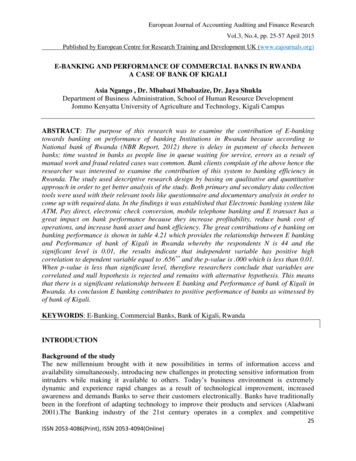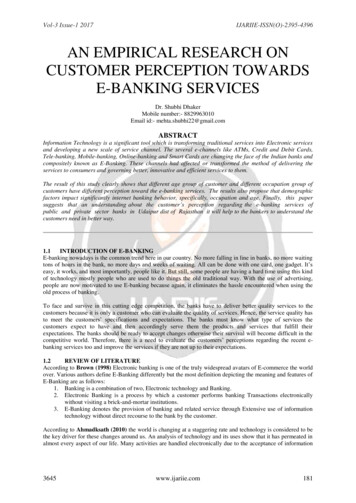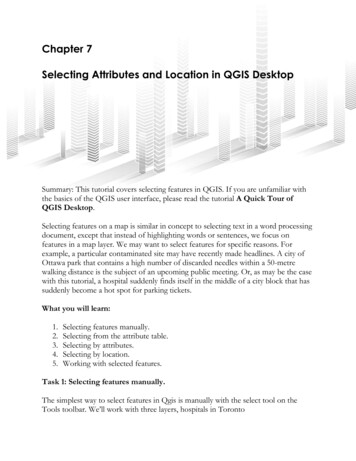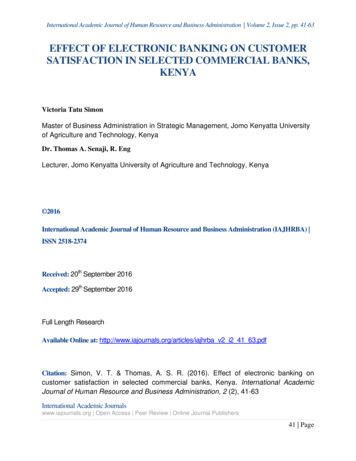
Transcription
Publication date13 Nov 2020AuthorPhilip BentonSenior AnalystSelecting a DigitalBanking Platform,2020–21SBrought to youyou byby InformaInformaTechTech
Omdia Universe: Selecting a Digital Banking Platform,2020–21SummaryCatalystThe COVID-19 pandemic has accelerated the trend for digital to be the primary interaction andoriginating channel; thus, implementing a next-generation digital banking platform is essential.Omdia Universe: Selecting a Digital Banking Platform, 2020–21 will help the CIO, heads of digital,and digital channel executives to select the digital banking platform that provides the capabilitiesthey require and enables their digital transformation ambitions.Figure 1: The Omdia Universe for Digital Banking PlatformsSource: Omdia 2020 Omdia. All rights reserved. Unauthorized reproduction prohibited.01
Omdia Universe: Selecting a Digital Banking Platform,2020–2102Omdia viewAn optimized digital banking experience is integral to the future success or, possibly, survival of abank. It requires an ability to rapidly build and deliver ongoing development, whether institutions goit alone or partner with a technology vendor. Having the ability to incorporate and harness newtechnologies and capabilities will be the key to success. A modern digital banking platform needs tobe adaptable and flexible but also have the ability to scale without impacting performance; this hasled to a modular microservices-led architecture becoming the norm. Deployment by cloud isincreasingly in demand, because it enables banks to manage their infrastructure costs moreefficiently (than with on-premises deployment) and future-proof their services.The question is no longer simply about having a digital banking presence but about how the platformcurates and personalizes the experience for an existing or target customer group. A seamless digitalcustomer journey must be the ultimate objective of all banks (whether it is for query resolution,product applications, or personalized money management), underpinned by a digital bankingplatform that embraces machine learning (ML), natural language processing, and open APIs, none ofwhich the customer should be able to notice. With the rise of financial technology (fintech), digitalbanking platform vendors are increasingly creating a partner ecosystem that enables widerfunctionality through preconfiguration and avoids lengthy integration processes. The technologyinvestment in the digital banking platform should be closely integrated and aligned with customerengagement platforms that support wider employee-to-customer interactions and digital selfservice customer journeys.Key messages Implementing a modern microservices-enabled digital banking platform is a vital element ofdigital transformation in order to support scalability. A cloud-native approach to platform innovation is a key future requirement, because retailbanks need to adapt and innovate at speed. Implementing a platform with extensive capabilities is not necessarily the right approach for allretail banks. Consider a solution that aligns with the size, complexity and breadth of the bank’srequirements and has the ability to drive the innovation and partnership model it wishes to havewith the vendor. An open banking and ecosystem approach means that platforms do not necessarily need to bethe most complete or richest in terms of business functionality. Future innovation will be drivenby the ecosystem. There are still many vendors in the digital banking space, despite the fact that there have been anumber of acquisitions and mergers over the past few years. 2020 Omdia. All rights reserved. Unauthorized reproduction prohibited.
Omdia Universe: Selecting a Digital Banking Platform,2020–2103 Backbase, Infosys Finacle, Oracle, and Temenos are all leaders in this report, thanks to theircombination of market impact, solution capabilities, and customer experience. The challengers, CR2, Finastra, Intellect Design Arena, Sopra, and Technisys, all have strongsolutions that often provide a very good customer experience but are not yet leading in terms ofoverall market presence or solution capabilities. Although Comviva, ebankIT, and Fiserv are prospects, their solutions deserve strongconsideration for certain market segments or platform requirements. 2020 Omdia. All rights reserved. Unauthorized reproduction prohibited.
Omdia Universe: Selecting a Digital Banking Platform,2020–2104Analyzing the digital bankingplatform universeHow to use this reportOmdia is a proud advocate of the business benefits derived through technology, and digital bankingplatforms are at the forefront of realizing benefits to front-office staff across the globe. The OmdiaUniverse report is not intended to advocate an individual vendor but rather to guide and inform theselection process to ensure all relevant options are considered and evaluated efficiently. Reportfindings gravitate toward the customer’s perspective and likely requirements, while taking intoconsideration the varying states of digital transformation occurring in financial institutionsthroughout the world, and deployments are considered for retail banks globally. There are manyvendors in the digital banking platform solutions market, and all vendors included in this report aredeemed to be of high merit and worthy of consideration for short-listing purposes.Market definitionOmdia has defined a digital banking platform as a standalone front-office solution that enablesfinancial institutions to enhance the end-user experience without the need to overhaul their existingcore banking systems. It must be a channel platform for online banking and mobile banking tosupport servicing, origination, and customer interaction/communication through these channelsand, also, a wider digital platform that supports digital front office. The specific functionalityrequired to be considered a digital banking platform includes online banking, mobile banking,customer engagement, employee engagement, origination/onboarding, digital marketing/customercommunication, analytics, and multichannel management/integration: Online banking. End-user internet-based access portal for basic banking functionality (e.g.,account information and payment transfers) plus additional services (e.g., personal financialmanagement, open banking, chatbots personalization, and visualization tools). Mobile banking. Support for mobile banking including via SMS, WAP, smartphone, and tabletwith the same functionality as online banking as well as biometric and facial-recognitiontechnology. Origination/onboarding. The ability to support direct digital applications and fully automateonboarding of clients. Customer engagement. The end-user experience and the ability to independently access,manage, and customize end users’ account information. 2020 Omdia. All rights reserved. Unauthorized reproduction prohibited.
Omdia Universe: Selecting a Digital Banking Platform,2020–2105 Employee engagement. The ability for banking personnel to communicate with the client on thedigital banking platform and via all devices and to monitor and improve the customerexperience. Digital marketing and customer communication. The platform’s ability to provide in-applicationmarketing alerts, banner adverts, and targeted marketing message support and to deliver andmanage customer communications including interaction with omnichannel requirements. Analytics. Metrics collected about interactions between customers and banks, including theability to track everything from individual customer journeys across multiple devices andchannels to revenue generated per customer. Multichannel management and integration. Managing the omnichannel experience within thedigital channels, contact center, ATM, kiosk, and the branch and the ability to integrate newdigital channels (e.g., smart watches, augmented/virtual reality) when required.Market dynamicsA digital banking platform is now considered essential by retail banks of all sizes as they struggle tokeep up with the latest technology. This has prompted many banks to outsource their digital frontoffice capabilities to a third-party solution provider. Consequently, the digital banking platformvendor marketplace has become increasingly crowded: Omdia estimates there are 25–30 truly globaldigital banking platform providers and a plethora of regional/local players. Comviva, ebankIT, andTechnisys feature in the Omdia Universe for the first time as new entrants. The increased number ofvendors is despite consolidation in the industry, notably Temenos’ acquisition of former marketchallenger Kony in 2019. Retail banks, therefore, have more choice than ever—reflected in a largervendor short list than in the 2019 report—and should carefully consider the capabilities they requirebefore selecting their long-term partner. In the Omdia Universe, various different approaches havebeen highlighted from highly customized complex solutions deployed across multiple entities tomore packaged off-the-shelf solutions that can be implemented rapidly and at minimal cost.Fundamental to every digital banking platform solution is speed and flexibility, with retail banksseeking to launch new products and services rapidly through their digital capabilities. Platforms arerequired to offer microservices as standard, allowing the bank to evaluate the level of customerengagement before releasing a full suite of digital products. Speed is important, not just forlaunching products but for the entire user experience, whether it is for first-time onboarding or dayto-day app usage. Vendors that recognize the importance of speed and flexibility have performedstrongly in this report.Open APIs are another important aspect for today’s platforms as open banking provides retail bankswith the chance to unlock new digital services and revenue-generating opportunities. Digital bankingplatforms need to be built with an API-as-a-product mindset, and vendors that were able todemonstrate live use cases of their open API capabilities scored highly in the Omdia Universe as aresult. Open APIs are important not just to retail banks but also to vendors looking to expand theirplatform capabilities through a wider partner ecosystem. Vendors are required to embrace 2020 Omdia. All rights reserved. Unauthorized reproduction prohibited.
Omdia Universe: Selecting a Digital Banking Platform,2020–2106partnership opportunities with third-party providers through adoption of the marketplace model.Whether vendors open their APIs to partner with other technology providers in order to add value tothe ecosystem was also an important consideration.Digital expectations change at a rapid rate that requires agility, flexibility, and forward thinking.Therefore, selecting a platform is not just about choosing the best off-the-shelf product for mostbanks; it is also necessary to consider a vendor’s ability to support the bank’s aspirations. Thisrequires a strong partner, one that enables and drives innovation and a strong customer experienceand provides advice on how to launch new products and services quickly and effectively.Figure 2: Vendor positioning in the Digital Banking Platform UniverseSource: OmdiaMarket leadersBackbase is a market leader thanks to its strong platform functionality and straightforwardintegration, which enables banks to efficiently add new business capabilities. Backbase’sengagement banking platform is highly adaptable and has been deployed with large and smaller 2020 Omdia. All rights reserved. Unauthorized reproduction prohibited.
Omdia Universe: Selecting a Digital Banking Platform,2020–2107institutions. Backbase scored the maximum mark for its solution innovation capabilities, boostedthrough its large fintech partner marketplace.Infosys Finacle will appeal to banks that require a broad set of capabilities across multiple entitiesand has the widest solution breadth of all the vendors, which is why it is a leader. The solution ishighly componentized, and Infosys has experience in deployment at incumbent banks as well asdigital startups. Finacle is an early adopter of open banking and will appeal particularly to banksstarting out on their open banking journey.Oracle is positioned as a leader because of its one-stop approach to serving digital banking needs.Oracle has a very rich platform, which provides broad functionality in terms of both business andtechnological capabilities. This enables the vendor to cater for all types of financial institutions. Thevendor scored strongly in all categories but has particular strength in its breadth of functionalityincluding its forward-thinking approach to open APIs.Temenos is a leader because of its comprehensive digital banking solution, which scored highest forproduct experience and solution innovation. Infinity has an impressive array of analytics tools at itsdisposal, with the platform designed for hyperpersonalization. Temenos’ strengths lie in providing anexcellent user experience, for both business and end users, and an impressive product roadmap thataligns well with future market trends.Market challengersCR2 achieves its position as a market challenger because of its highly adaptable platform,BankWorld, which has strong omnichannel and payments functionality. The vendor is well versed innavigating regulatory constraints and would suit banks in developing regions. Strong areas aremultichannel integration, payments, and platform adaptability.Finastra appears as a challenger because the platform possesses strong capabilities and a widebreadth of functionalities that meet both digital and core banking needs. Finastra has a largeecosystem of fintech partners with which it collaborates to enable wider platform functionality.Areas of strength are omnichannel capabilities, fintech collaboration, and customer support.Intellect Design Arena is a challenger thanks to its extensive platform capabilities and solutioninnovation. The platform enables easy integration of existing systems through its integration studio(Olive Fabric) and accelerates the launch of new products using its Experience Design Studio. It hasparticularly strong capabilities for innovation, platform adaptability, and solution functionality.Sopra is a challenger thanks to the innovation of its solution, which embraces the opportunities ofopen APIs and marketplace collaboration. Sopra has experience in deploying with all tiers of banks,and the platform is capable of orchestrating fully digital personalized customer experiences. Areas ofstrength include open banking, innovation strategy, and customer support.Technisys will appeal to banks, particularly digital startups, that favor a flexible but scalableplatform, which is why it achieved challenger status. The platform is increasingly focused on clouddeployments and has received plaudits from customers for its ability to support rapid deploymentsand enable new business capabilities. Strong areas are its API-centric architecture, innovation, andpartner-led approach to customer support. 2020 Omdia. All rights reserved. Unauthorized reproduction prohibited.
Omdia Universe: Selecting a Digital Banking Platform,2020–2108Market prospectsComviva provides capabilities for retail banks starting on their digital journey, particularly indeveloping markets, which makes it a prospect in this report. It does not have the breadth ofcapabilities of its competitors but does provide highly relevant capabilities for its target markets, andthe mobiquity platform is judged to be very innovative. Comviva’s strongest features are its supportof emerging channels, user experience, and payments capabilities.Offering an off-the-shelf platform while still retaining an element of flexibility, ebankIT is a prospect.Its middleware contains all the modules needed for a digital financial institution, making it a moreaffordable proposition for banks at Tier 2 and below. The vendor has a growing number of partnersthrough the ebankIT marketplace. The solution’s strength lie in its speed of deployment,multichannel capabilities, and integration.Fiserv’s DigitalAccess provides a good level of platform capabilities and solution breadth out of thebox, which makes the vendor a prospect for Asia Pacific; Europe, the Middle East, and Africa (EMEA);and Latin America. The DigitalAccess platform has strong usability and is favored by retail banks thatprefer a one-stop approach to meeting their digital needs. Fiserv’s strongest areas are its breadth ofpayments capabilities, multichannel integration, and the platform’s end-to-end functionality.Market outlookThe COVID-19 pandemic has accelerated an already high demand for digital banking solutions, withmore than a third of retail banks having significantly increased their online and mobile bankingpriorities because of it, according to Omdia’s ICT Enterprise Insights 2020/21 survey. Consequently,global spend on digital banking is expected to grow at a CAGR of 5% to reach 17 billion in 2024,compared with 14 billion in 2020, proving there is plenty of market share available for digitalbanking platform vendors. However, it is expected that there will be a period of consolidationamong banking software vendors, which would continue the trend of mergers and acquisitions thathas occurred in the fintech industry during past two years, particularly if big tech elects to getinvolved. The evolution of digital banking platforms requires banks to continually invest in thetechnology, the top priority being to enhance existing platform functionality to aid self-service,according to Omdia’s ICT Enterprise Insights 2020/21 survey (Figure 3). Although retail banks intendto use a digital banking platform to aid self-service, they also want to integrate the digital channelexperience with other channels, which is the top priority for 19% of respondents. That requiresplatforms to have strong omnichannel capabilities. 2020 Omdia. All rights reserved. Unauthorized reproduction prohibited.
Omdia Universe: Selecting a Digital Banking Platform,2020–2109Figure 3: Enhancing self-service platform functionality is number one priority for retail banksSource: Omdia ICT Enterprise Insights 2020/21Digital banking is shifting to a platform approach that incorporates the wider digital front office.Retail banks will no longer have siloed separated systems for online/mobile banking and otherchannel systems but a broader digital banking platform that supports customer-to-bank interactionsfor direct and, increasingly, emerging channels. Artificial intelligence (AI) has long been spoken aboutas a way of reducing staff costs and replacing service capabilities. It is, therefore, no surprise thataccording to Omdia’s ICTEI survey (Figure 3), enhanced automated interaction capabilities is one ofthe top three IT projects in digital banking for more than a third of banks. Software vendors with anAI/ML specialism will be highly sought after if their digital platforms can demonstrate a wide rangeof ML applications, both customer facing and for internal systems, while also having the flexibility tobe implemented on premises or in the cloud. Retail banks should view their software provider as apartner, not a vendor, when selecting their preferred platform. Digital expectations change at arapid rate that requires agility, flexibility, and forward thinking. Change will require a strong partnerthat is able to respond to these challenges and provide advice on how to launch new products andservices quickly and effectively. 2020 Omdia. All rights reserved. Unauthorized reproduction prohibited.
Omdia Universe: Selecting a Digital Banking Platform,2020–2110Vendor analysisBackbase (Omdia recommendation: Leader)Backbase should appear on your short list if you are looking to upgrade a legacy solution and havecomplex and extensive requirementsBackbase is a privately owned, financial services–focused digital platform vendor headquartered inthe Netherlands. The company was founded in 2003 and launched the Backbase engagementbanking platform in 2009. Backbase started as a portal platform that was developed for online andmobile banking modernization projects for top-tier banks, and it has evolved into a complete digitalbanking platform. Because the platform was created specifically for digital banking and as afacilitator to enable strong customization, Backbase has historically had a strong global client base,including Tier 1 and Tier 2 banks, but it has also gained considerable traction among smaller bankssince it turned its offering into a digital banking platform product. The company continues to growrapidly: it now has approximately 1,000 employees, a considerable increase from a headcount of 690in 2018. As a specialist digital banking platform vendor, Backbase derives all its company revenuethrough its digital banking platform. The vendor has grown organically and enjoyed exponentialgrowth for a number of years, despite operating in an increasingly competitive marketplace.Backbase invests half of its revenue in research and development as it seeks to enhance the featuresand services provided by the platform. The vendor describes itself as the “AWS of banking” becauseits platform is core agnostic and built on a single omnichannel banking platform architecture ratherthan having been built through acquisitions. The platform has a vast array of features and is bestsuited to banks that suffer with a spaghetti architecture and are locked into a legacy core providerand favor a cloud-first approach. Customer feedback is strong: it has been remarked how easy tointegrate with other services the Backbase platform is, and it enables banks to efficiently add newbusiness capabilities. 2020 Omdia. All rights reserved. Unauthorized reproduction prohibited.
Omdia Universe: Selecting a Digital Banking Platform,2020–2111Figure 4: Omdia Universe ratings – BackbaseSource: OmdiaStrengthsThe Backbase platform is built on a microservices architecture that enables banks to “pick and mix”their preferred digital capabilities from an extensive back catalog of functionalities. The flexibility ofthis approach enables banks to customize the platform prior to deployment and also supportongoing innovation. Backbase has extensive experience of integrating with the major core bankingproviders thanks to a large number of deployments with Tier 1 and Tier 2 banks, which makesdeployment more straightforward for larger institutions. The vendor has sales and support offices inall regions and has deployed its solution in a wide variety of countries. The platform provides anexcellent end-user experience and provides many new business capabilities while allowing scalabilityin customer numbers without a drop in performance. It also has a strong analytics engine that allowsbusiness users to identify new opportunities to engage with customers. Backbase has a very strongemphasis on research and development with half of its revenue invested back into R&D, aconsiderably higher-than-average percentage, which has led to some Backbase clients describing theplatform as market leading. 2020 Omdia. All rights reserved. Unauthorized reproduction prohibited.
Omdia Universe: Selecting a Digital Banking Platform,2020–2112LimitationsThe Backbase engagement banking platform has leading and rich functionality for the primary digitalchannels, but Backbase is not yet the leading vendor across the broader digital front office, althoughthis has been partially addressed in recent years with a significant investment in expanding theplatform functionality, particularly the Employee App, which allows a 360-degree view of customers.The platform is designed to be self-serving and historically suited banks with strong digitaldevelopment functions, but it is increasingly being adopted by banks without technology capacitybecause of the support Backbase is providing after significantly scaling up its global customer successteams and increasingly making the product configuration based.OpportunitiesThe pandemic has accelerated the timescales of the digital transformation plans of many banks fromyears to months. Backbase is well positioned to profit from the increased demand because of thespeed at which the vendor can deploy its platform. Backbase partners with a wider range of fintechsolution providers (more than 70 to date) through its Open Banking Marketplace and haspartnerships in core banking, payments, and security to name a few. Backbase should continue toadd partners to this marketplace to expand its ecosystem and accelerate the scalability of itsplatform in order to compete effectively with vendors that are able to offer the whole packageunder one brand. The mid-tier banking segment is increasingly adopting a cloud-first mindset, andBackbase is well placed to support deployments occurring in the cloud and is advanced in itscontainership deployment strategy, having already embraced the Kubernetes approach, which hasenabled the vendor to be fully cloud agnostic and launch its own Backbase-as-a-service offering.ThreatsBackbase’s major threat is its ability to maintain high levels of support as it continues to scale andexpand its client base, although the vendor has already made great strides in North America withmore than 150 employees now based out of four locations in the US and Canada. Backbase hasdemonstrated a level of success with smaller institutions in North America, but it will need to sustainthis growth in other regions if it is to replicate the success it has had with larger institutionsglobally. The vendor has already made the transition to the cloud but will need to support the highdemands of top-tier clients while maintaining cloud software-as-a-service (SaaS) offers for smallerinstitutions. Although Backbase has strong open API capabilities and compatibility with openbanking, it is still unclear how the vendor will deploy these capabilities on its roadmap.Comviva (Omdia recommendation: Prospect)Comviva should appear on your short list if you are looking to deploy a mobile-first banking solutionin a developing marketComviva, headquartered in Gurugram, India, was founded in 1999 and historically focused onproviding value-adding services to telecommunication providers. It has focused on serving bankssince 2014. The vendor is privately owned with Tech Mahindra, the Indian multinational IT servicesprovider, acquiring a 51% stake in 2012. Comviva’s digital banking platform, the mobiquity bankingsuite, was launched in 2015, and it has had considerable success in deploying its solution withflagship banks in India and the Middle East and in Tier 5 banks (those with less than 1 billion inassets) in the African region. The solution has evolved from a mobile payments product into a fully 2020 Omdia. All rights reserved. Unauthorized reproduction prohibited.
Omdia Universe: Selecting a Digital Banking Platform,2020–2113fledged channel platform. The platform adopts a modular approach with banks able to “plug andplay” by selecting their building blocks from a digital experience layer, digital transaction layer, anddigital payment module. Comviva has a small but growing dedicated team that works exclusively onenhancing the features and functionality of the platform. Comviva’s key geographic focus is India,Africa, and the Middle East, although Europe and Latin America are also regions the vendor istargeting. Its digital banking revenue, although small, has been growing at a rapid rate since it wasselected by a number of African banks launching inaugural digital banking services. The platform hasbeen well received by banks who are launching digital services for the first time, but Comviva alsosupports digital mature banks including some of the largest banks in India and the Middle East. Theplatform is suitable for banks that are looking for an off-the-shelf product that can still be adapted totheir specific needs, and it has been rated one of the top vendors in terms of its aftersales customersupport, making Comviva the ideal partner for banks or fintechs that are embracing digital bankingfor the first time.Figure 5: Omdia Universe ratings – ComvivaSource: Omdia 2020 Omdia. All rights reserved. Unauthorized reproduction prohibited.
Omdia Universe: Selecting a Digital Banking Platform,2020–2114StrengthsSince starting in mobile payments, Comviva has particular strength in supporting a variety ofpayment rails including digital wallets, P2P payments, QR codes, and A2A payments, and thearchitecture is built with instant payments in mind. Comviva enjoys a reputation for being aninnovator for the developing markets it supports and has partnered with many banks that are thefirst in their country to launch a digital banking service, demonstrating that its platform is able toadapt to a variety of local regulations. The platform has been rated as having a strong end-userexperience, particularly on mobile deployments thanks to its telco provider heritage, and Comviva’splatform has been cited as a core reason for accelerating digital customer onboarding. Although ithas a small team, Comviva is able to provide real-time support to its banking clients during and afterimplementation to ensure any teething issues are resolved quickly.LimitationsThe breadth and capabilities of the mobiquity platform are relatively narrow because of its focus ondelivering mobile financial services, and some of the new features on its roadmap (e.g., openbanking capabilities) have already been deployed by other vendors. There is limited ability tocustomize the core functionality, and the vendor does not have much experience integrating withnonlegacy core banking providers, although the preconfiguration with legacy core banking providersenables a rapid deployment timeframe for product migration. Comviva has limited experience withdeploying the platform on a multi-entity scale or across different lines of the business, so it is unclearat this stage whether mobiquity wo
digital banking platform providers and a plethora of regional/local players. Comviva, ebankIT, and Technisys feature in the Omdia Universe for the first time as new entrants. The increased number of vendors is despite consolidation in the industry, notably Temenos' acquisition of former market challenger Kony in 2019.











